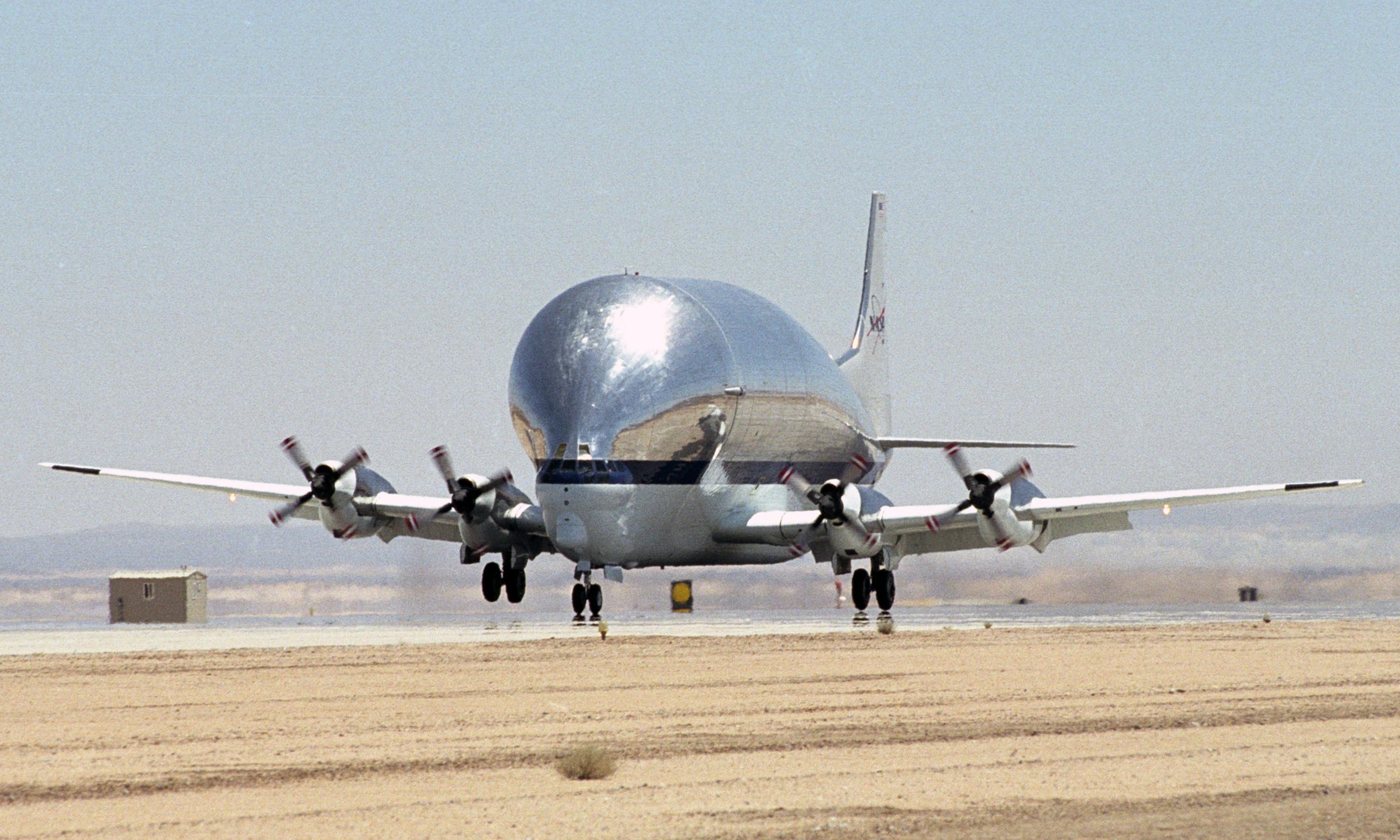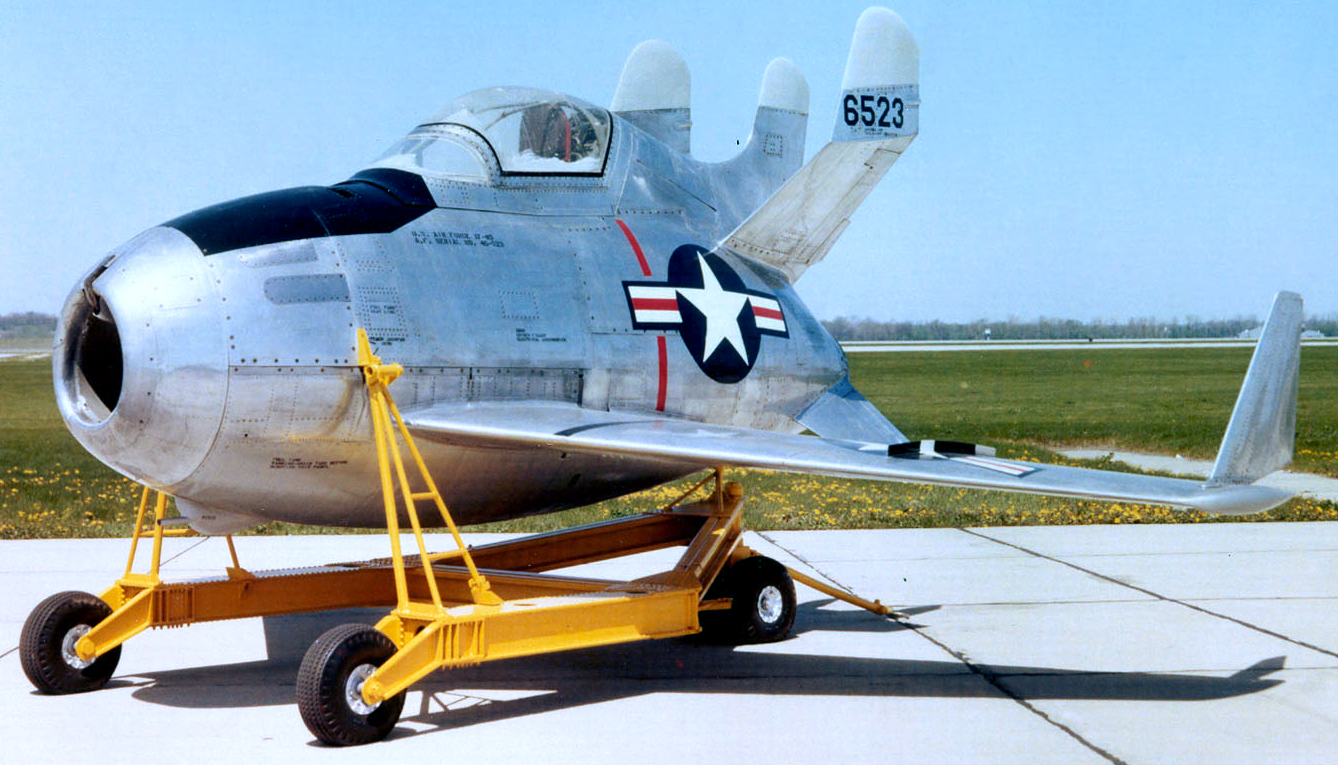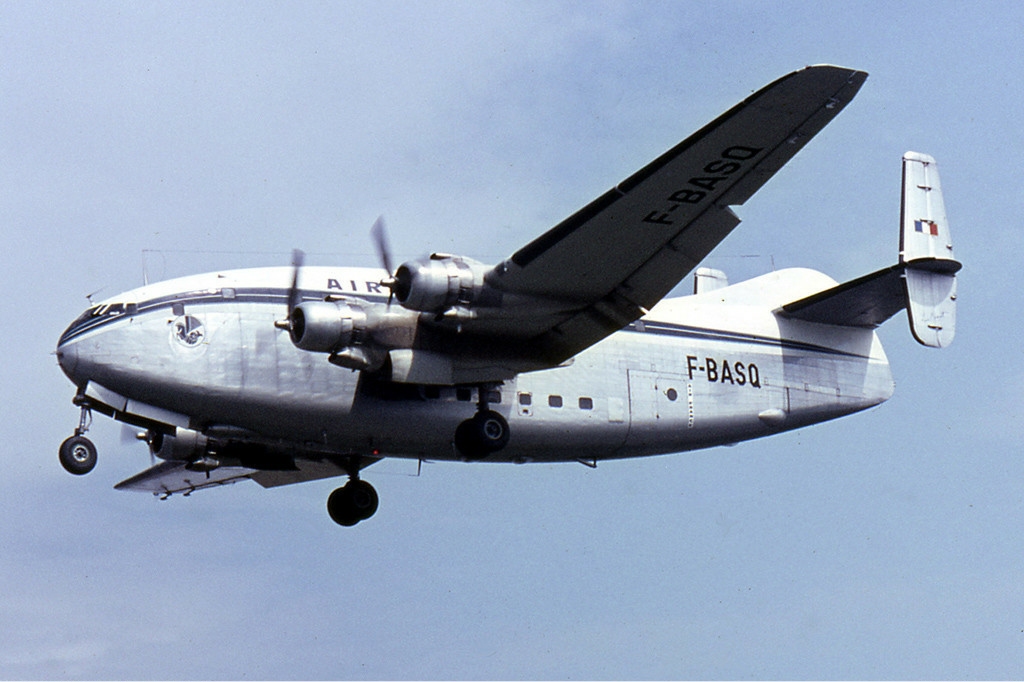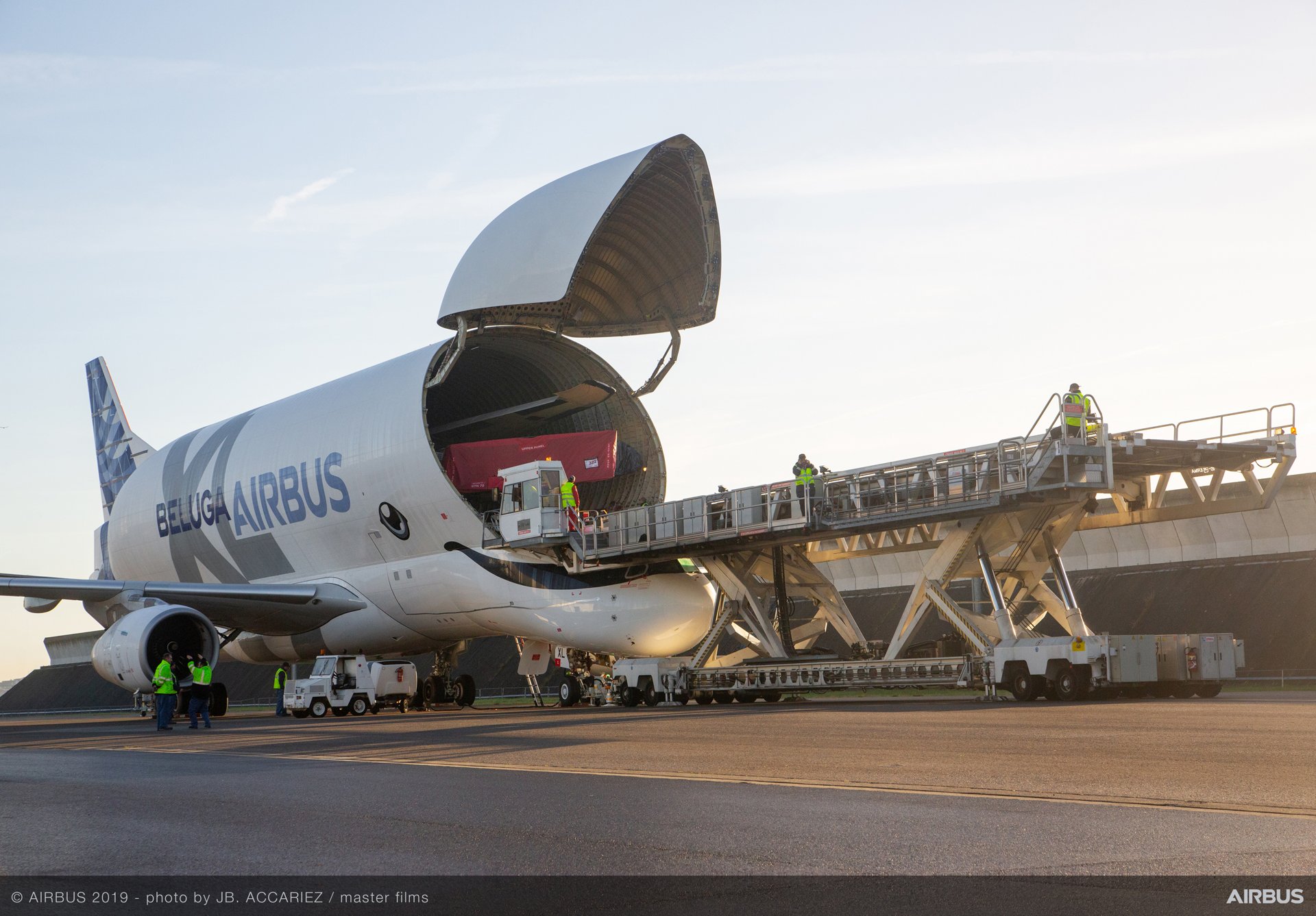Aerospace
Worlds Ugliest Aircraft

The Super Guppy
 Courtesy: Wikipedia
Courtesy: Wikipedia
The Aero Spacelines Super Guppy is a large, wide-bodied cargo aircraft that is used for hauling outsize cargo components. It was the successor to the Pregnant Guppy, the first of the Guppy aircraft produced by Aero Spacelines. Five were built in two variants, both of which were colloquially referred to as the “Super Guppy”
[adinserter block=”1″]
The first, the Super Guppy, or “SG”, was built directly from the fuselage of a C-97J Turbo Stratocruiser, the military version of the 1950s Boeing 377 “Stratocruiser” passenger plane. The fuselage was lengthened to 141 feet (43 m), and ballooned out to a maximum inside diameter of 25 ft (7.6 m), the length of the cargo compartment being 94 ft 6 in (28.8 m). The floor of the cargo compartment was still only 8 ft 9 in (2.7 m) wide, as necessitated by the use of the Stratocruiser fuselage.
In addition to the fuselage modifications, the Super Guppy used Pratt & Whitney T-34-P-7 turboprop engines for increased power and range, and modified wing and tail surfaces. It could carry a load of 54,000 pounds (24,494 kg) and cruise at 300 mph (480 km/h).
[adinserter block=”12″]
De-Havilland-DH-106-Comet-C4-aircraft

Courtesy: Wikipedia
The de Havilland DH.106 Comet was the world’s first commercial jet airliner. Early Comet models suffered from metal fatigue, causing a string of accidents. The redesigned Comet 4 series enjoyed a long and productive career of over 30 years.Was operated by Royal Aircraft Establishment Bedford on Nimrod AEW radar trials. The aircraft was later scrapped at Bedford.
[adinserter block=”13″]
McDonnell XF-85

McDonnell XF-85 Goblin – Wikipedia
The McDonnell XF-85 Goblin was an American prototype fighter aircraft conceived during World War II by McDonnell Aircraft. It was intended to be deployed from the bomb bay of the giant Convair B-36 bomber as a parasite fighter. The XF-85’s intended role was to defend bombers from hostile interceptors, a need demonstrated during World War II. Two prototypes were constructed before the program was terminated.
[adinserter block=”12″]
Transavia PL-12 Airtruk

Courtesy: Wikipedia
The Transavia PL-12 Airtruk is a single-engine agricultural aircraft designed and built by the Transavia Corporation inAustralia. The Airtruk is a shoulder-wing strut braced sesquiplane of all-metal construction, with the cockpit mounted above a tractor engine and short pod fuselage with rear door. The engine cowling, rear fuselage and top decking are of fibreglass. It has a tricycle undercarriage, the main units of which are carried on stub wings. It has twin tail booms with two unconnected tails. Its first flight was in 22 April 1965, and was certified on 10 February 1966The Airtruk is also sometimes known as the Airtruck. Because the name “Airtruck” was registered by the New Zealand companies Bennett Aviation Ltd and Waitomo Aircraft Ltd, for their PL-11, Transavia found another name for their PL-12 (“Airtruk”)
[adinserter block=”2″]
The PL-11 Airtruck

Courtesy: Wikipedia
[adinserter block=”3″]
The PL-11 Airtruck was in fact a successful crop-duster, appreciated by the pilots who flew it for a living. Only two were built, in New Zealand, but some of the 118 examples of its successor, the Australian Transavia PL-12 Airtruk, are still at work all over the world. The Airtruck and Airtruk were designed for a specific job—aerial application—rather than adapting a conventional airplane to the task. The pilot was placed high above both the engine and the chemicals hopper, rather than sitting between them waiting to be crushed in a crash, and the perch gave him a superb view for low-level maneuvering.
The Deux-Ponts

Courtesy: Wikipedia
If the Lockheed Constellation was a dolphin, the Deux-Ponts was a manatee. Yet it was an excellent airplane, flying for Air France, the French Armée de l’Air and a few smaller operators from 1952 through 1971. With two full passenger decks, it could seat 135 in a pinch, substantially more than its only double-deck competition, the Boeing 377 Stratocruiser—which in fact had only a partial lower deck configured as a cocktail lounge. But it was unpressurized and had a capacity far beyond what any airline of the time needed.
[adinserter block=”2″]
Short Sturgeon SB3

Courtesy: Wikipedia
The Short Sturgeon was a planned British carrier-borne reconnaissance bomber whose development began during Second World War with the S.6/43 requirement for a high-performance torpedo bomber, which was later refined into the S.11/43 requirement which was won by the Sturgeon. With the end of the war in the Pacific production of the aircraft carriers from which the Sturgeon was intended to operate was suspended and the original reconnaissance bomber specification was cancelled
[adinserter block=”12″]
Boeing – Phalcon 707

Courtesy: Wikipedia
The EL/M-2075 is a solid-state L-band conformal array radar system for use on a Boeing 707 and other aircraft. Phalcon, as the complete AEW mission suite is referred to, is intended for airborne early warning, tactical surveillance of airborne and surface targets and intelligence gathering. It also integrates the command and control capabilities needed to employ this information
[adinserter block=”12″]
The system can be fitted to a number of aircraft, including the Boeing 707, Boeing 767, Boeing 747 series aircraft. Under a contract signed with Chile in 1989, the first Phalcon system to be installed was fitted to a former LanChile Boeing 707, and was first flown in 1993. In May 1994 the aircraft was delivered to the Chilean Air Force, where it is known as the Condor.
Avro Shackleton
Courtesy: Wikipedia
The Avro Shackleton was a British long-range maritime patrol aircraft for use by the Royal Air Force (RAF) and the South African Air Force (SAAF). It was developed by Avro from the Avro Lincoln bomber, itself being a development of the famous wartime Avro Lancaster bomber. The type is named after the polar explorer Sir Ernest Shackleton.
[adinserter block=”2″]
Entering service with the RAF in 1951, the Shackleton was used primarily in the anti-submarine warfare (ASW) and maritime patrol aircraft (MPA) roles; it also became used as a search and rescue (SAR) platform and for performing several other secondary roles such as being a troop-transport. In later life, a small number of the RAF’s Shackletons were subsequently adapted for airborne early warning (AEW) duties, performing in this capacity until the type’s retirement in 1991. The Shackleton was also procured by South Africa, and would be operated by the SAAF between 1957 and 1984.
RAF victor
The Handley Page Victor was a Britishjet-power edstrategic bomber, developed and produced by the Handley Page Aircraft Company, which served during the Cold War. It was the third and final of the V-bombers operated by the Royal Air Force(RAF), the other two V-bombers being the Avro Vulcan and the Vickers Valiant. The Victor had been developed to perform as part of the United Kingdom’s airborne nuclear deterrent. In 1968, the type was retired from the nuclear mission following the discovery of fatigue cracks, which had been exacerbated by the RAF’s adoption of a low-altitude flight profile to avoidinterception.
Classic Collections
GeeBee
The Gee Bee Model R Super Sportster was a special purpose racing aircraft made by Granville Brothers Aircraft of Springfield, Massachusetts at the now-abandoned Springfield Airport (Massachusetts). Gee Bee stands for Granville Brothers. The 1932 R-1 and its sister plane, the R-2, were the successors of the previous year’s Thompson Trophy-winning Model Z.
[adinserter block=”1″]
hughes XH-17 , helicopter

Courtesy: Wikipedia
The XH-17 “Flying Crane” was the first helicopter project for the helicopter division of Hughes Aircraft. The XH-17, which had a two-bladed main rotor system with a diameter of 134 feet (41 m), was capable of flying at a gross weight of more than 50,000 pounds (23,000 kg).
[adinserter block=”1″]
How has Boeing’s B787 dreamliner turned into a nightmare?
Kamov Ka-226

Courtesy: Wikipedia
The Kamov Ka-226 “Sergei” is a small, twin-engined Russian utility helicopter. The Ka-226 features an interchangeable mission pod, rather than a conventional cabin, allowing the use of various accommodation or equipment configurations. The Ka-226 entered service in 2002.
[adinserter block=”1″]
‘No need to revamp the cockpit crew alerting system in B737 max 10’ – Boeing
Boeing Dream Lifter

Courtesy: Wikipedia
Who will win the Indian Navy’s new fighter jet contract? F/A 18 or Rafale
The Boeing 747 Dreamlifter (formerly Large Cargo Freighter or LCF) is a wide-body cargo aircraft. Cargo is placed in the aircraft by the world’s longest cargo loader. It is an extensively modified Boeing 747-400 and is used exclusively for transporting 787 aircraft parts to Boeing’s assembly plants from suppliers around the world.
The Beluga

Courtesy: Wikipedia
The Airbus A300-600ST (Super Transporter) or Beluga, is a version of the standard A300-600 wide-body airliner modified to carry aircraft parts and oversized cargo. It was officially called the Super Transporter at first, but the name Beluga became popular and has now been officially adopted.
[adinserter block=”12″]

Airbus The BelugaXL delivers an “extra-large” role for its team
In 1991 Aérospatiale and DASA, two of the major Airbus partners, formed a company to develop a replacement. The starting point was the design for the wide-body twin-enginedAirbus A300: the wings, engines, landing gear, and the lower part of the fuselage are the same as the A300 while the upper part of the fuselage is an enormous horseshoe-shaped structure 7.7 m (25 ft) in diameter
[adinserter block=”13″]
They are ugly but their work contribution towards Aviation industries is Tremendous and Unique , We love this aircraft all time.
Source: Respective-companies-media-press. Wikipedia,
Twitter: #Worlds_Ugliest_Aircraft.
Share this Article to your friends and Family.

Aerospace
Boeing Transfers Rocket Stage to NASA, Paving Way for Human Moon Mission

Boeing has achieved a significant milestone by providing NASA with the second core stage of the Space Launch System (SLS) rocket.
This crucial component, crafted at NASA’s Michoud Assembly Facility (MAF), is set to propel the Artemis II crew into lunar orbit, marking humanity’s return to deep space after a 50-year hiatus.
The monumental Boeing-built rocket stage, the largest element of the Artemis II mission, will embark on a journey aboard the Pegasus barge, traveling 900 miles to NASA’s Kennedy Space Center.
Comparison of two legendary aircraft B777x vs B747 aircraft:Click here
Upon arrival, it will be meticulously integrated with other essential Artemis II components, including the upper stage, solid rocket boosters, and NASA’s Orion spacecraft within the iconic Vehicle Assembly Building. This intricate integration process is a vital step toward the eagerly anticipated Artemis II launch, slated for 2025.
“Boeing-built products helped land humankind on the moon in 1969, and we’re proud to continue that legacy through the Artemis generation,” remarked Dave Dutcher, vice president and program manager for Boeing’s SLS program. “Together, with NASA and our industry partners and suppliers, we are building the world’s most capable rocket and paving the way to deep space through America’s rocket factory in New Orleans.”
NASA, Lockheed Martin Reveal X-59 Quiet Supersonic Aircraft:Click here
The delivery of Core Stage 2 marks a significant achievement in the evolution of the SLS rocket. Towering over 200 feet and powered by four RS-25 engines, this core stage, coupled with two solid-fueled booster rockets, will generate a staggering 8.8 million pounds of thrust. This immense power is crucial to launching Artemis II and future missions into the vast expanse of space.
The SLS rocket stands unparalleled in its capability to transport both crew and substantial cargo to the moon and beyond in a single launch. Its extraordinary capacity will facilitate the delivery of human-rated spacecraft, habitats, and scientific missions to destinations including the moon and Mars, ushering in a new era of space exploration.
-

 Travel1 week ago
Travel1 week agoAir India to Expand US Operations with Three New Routes After a Decade
-

 Travel2 weeks ago
Travel2 weeks agoWhy We Should Avoid These Stamps in a Passport
-

 Airlines1 month ago
Airlines1 month agoInvestigations Reveal Fake Chinese Titanium in Boeing and Airbus Jets
-

 Tech4 weeks ago
Tech4 weeks agoChina’s CATL Plans 1,800-Mile Electric Plane Launch by 2027
-

 Airport3 days ago
Airport3 days agoTop 10 Largest Airports in the World by Size
-

 Aerospace4 weeks ago
Aerospace4 weeks agoChina’s Fighter Jets Turn Wings into Autonomous Drones
-

 Airlines4 days ago
Airlines4 days agoAir India Rolls Out A350s for Delhi-New York JFK and Newark Routes
-

 Defence3 weeks ago
Defence3 weeks agoBoeing Enhances Chinook with New Engines and Block II Upgrades at $96 Million









